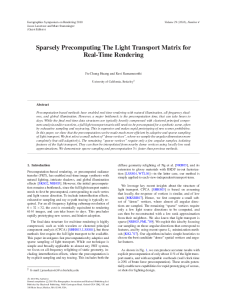Sparsely Precomputing The Light Transport Matrix for Real-Time Rendering
Abstract
Precomputation-based methods have enabled real-time rendering with natural illumination, all-frequency shadows, and global illumination. However, a major bottleneck is the precomputation time, that can take hours to days. While the final real-time data structures are typically heavily compressed with clustered principal component analysis and/or wavelets, a full light transport matrix still needs to be precomputed for a synthetic scene, often by exhaustive sampling and raytracing. This is expensive and makes rapid prototyping of new scenes prohibitive. In this paper, we show that the precomputation can be made much more efficient by adaptive and sparse sampling of light transport. We first select a small subset of “dense vertices”, where we sample the angular dimensions more completely (but still adaptively). The remaining “sparse vertices” require only a few angular samples, isolating features of the light transport. They can then be interpolated from nearby dense vertices using locally low rank approximations. We demonstrate sparse sampling and precomputation 5× faster than previous methods.
Citation
Fu-Chung Huang and Ravi Ramamoorthi. "Sparsely Precomputing The Light Transport Matrix for Real-Time Rendering". 21st Eurographics Symposium on Rendering, 29(4), June 2010.
Supplemental Material
Paper link to EG digital library

Video
Video showing the relighting phase.









